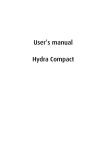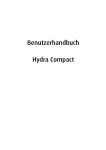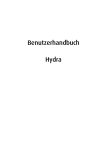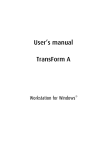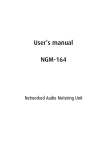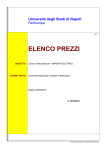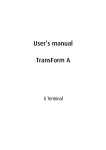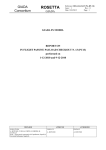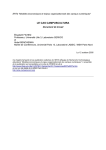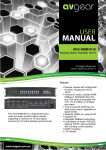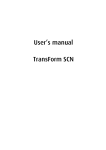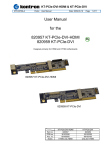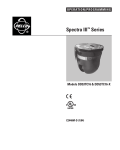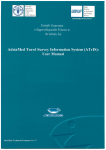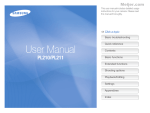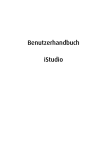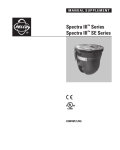Download User`s manual Hydra
Transcript
User’s manual Hydra R5976260, Current version Title: ID-no.: Revision: Date: HYDRA – User’s Manual R5976260 13 February-2007 main issue chapter 1 chapter 2 chapter 3 chapter 4 chapter 5 chapter 6 chapter 7 chapter 8 new: corr.: add.: update corr. add. add. corr. corr. add. The corresponding chapters are new or completely revised. Passages of the corresponding chapter were corrected; see modification bars. Passages of the corresponding chapter were added; see modification bars. This manual refers to following hardware components of HYDRA: Hydra unit R9830966 – Hydra Base 800W Document history Modifications, which result in a new version, are indicated by a vertical bar. Barco – Hydra – R5976260 – Revision 13 – February-2007 _________________________________________________________________________________________________________ ii Trademarks Brand and product names mentioned in this manual may be trademarks, registered trademarks or copyrights of their respective holders. All brand and product names mentioned in this manual serve as comments or examples and are not to be understood as advertising for the products or their manufacturers. Copyright © 1998-2007 by Barco Die Weitergabe sowie die Vervielfältigung aller Unterlagen, die von uns überlassen werden, deren Verwertung und Mitteilung ihres Inhaltes an Dritte ist nicht gestattet, soweit dies nicht ausdrücklich zugestanden ist. Urheberrechte, insbesondere auch solche an Software, werden nur insoweit übertragen, als es für die Erreichung des speziellen Vertragszwecks erforderlich ist. Zuwiderhandlungen können zu Schadensersatz verpflichten. Alle Rechte aus der Erteilung eines Patents oder der Eintragung eines Gebrauchsmusters verbleiben bei uns. Copyright © 1998-2007 by Barco All rights reserved. No part of this document may be copied, reproduced or translated. It shall not otherwise be recorded, transmitted or stored in a retrieval system without the prior written consent of Barco. Guarantee and compensation Barco provides a guarantee relating to perfect manufacturing as part of the legally stipulated terms of guarantee. On receipt, the purchaser must immediately inspect all delivered goods for damage incurred during transport, as well as for material and manufacturing faults. Barco must be informed immediately in writing of any complaints. The period of guarantee begins on the date of transfer of risks, in the case of special systems and software on the date of commissioning, at the latest 30 days after the transfer of risks. In the event of justified notice of complaint, Barco can repair the fault or provide a replacement at its own discretion within an appropriate period. If this measure proves to be impossible or unsuccessful, the purchaser can demand a reduction in the purchase price or cancellation of the contract (redhibition). All other claims, in particular those relating to compensation for direct or indirect damage, and also damage attributed to the operation of software as well as to other services provided by Barco, being a component of the system or independent services, will be deemed invalid provided the damage is not proven to be attributed to the absence of properties guaranteed in writing or due to the intent or gross negligence on the part of Barco. If the purchaser or a third party carries out modifications or repairs on good delivered by Barco, or if the goods are handled incorrectly, in particular if the systems are commissioned or operated incorrectly or if, after the transfer of risks, the goods are subject to influences not agreed upon in the contract, all guarantee claims of the purchaser will be rendered invalid. Not included in the guarantee coverage are system failures which are attributed to programs or special electronic circuitry provided by the purchaser, e. g. interfaces. Normal wear as well as normal maintenance are not subject to the guarantee provided by Barco either. The environmental conditions as well as the servicing and maintenance regulations specified in this manual must be complied with by the customer. Barco – Hydra – R5976260 – Revision 13 – February-2007 ________________________________________________________________________________________________________ iii Revision sheet To: • Barco Control Rooms GmbH An der Rossweid 5, D-76229 Karlsruhe Phone: +49-721-6201-0, Fax: +49-721-6201-298 E-mail: [email protected], Web: www.barcocontrolrooms.com From: Date: Please correct the following points in this documentation (R5976260): page wrong correct Barco – Hydra – R5976260 – Revision 13 – February-2007 ________________________________________________________________________________________________________ iv Contents 1 Introduction......................................................................................................................................... 1-1 1.1 How this manual is organized .....................................................................................................................1-2 1.2 Styles and symbols.......................................................................................................................................1-3 1.3 Safety instructions ........................................................................................................................................1-4 1.3.1 Standards .............................................................................................................................................1-4 1.3.2 Precautions ..........................................................................................................................................1-4 1.3.3 Unpacking of devices...........................................................................................................................1-6 1.3.4 Installation ...........................................................................................................................................1-6 1.3.5 Servicing...............................................................................................................................................1-6 1.3.6 Cleaning ...............................................................................................................................................1-6 1.3.7 Re-packing ...........................................................................................................................................1-6 1.4 Online documentation..................................................................................................................................1-7 2 Summary ............................................................................................................................................. 2-1 2.1 Properties......................................................................................................................................................2-2 3 Getting started .................................................................................................................................... 3-1 3.1 Examining .....................................................................................................................................................3-2 3.1.1 Hydra ....................................................................................................................................................3-2 3.2 Cabling ..........................................................................................................................................................3-6 3.2.1 Power supply .......................................................................................................................................3-6 3.2.2 Single board computer ........................................................................................................................3-7 3.2.3 Overlay input card ...............................................................................................................................3-8 3.2.4 Video input card...................................................................................................................................3-9 3.2.5 RGB input card ...................................................................................................................................3-14 3.2.6 Output card ........................................................................................................................................3-15 3.2.7 Audio board........................................................................................................................................3-19 3.2.8 Parthenope ........................................................................................................................................3-20 3.2.9 NGM-164 ............................................................................................................................................3-23 3.2.10 Patch panel ......................................................................................................................................3-24 3.3 Starting up ..................................................................................................................................................3-25 3.3.1 Connecting .........................................................................................................................................3-25 3.3.2 Switching on ......................................................................................................................................3-26 3.3.3 Switching off ......................................................................................................................................3-26 4 Operating ............................................................................................................................................ 4-1 4.1 BIOS and boot agent settings ......................................................................................................................4-2 4.1.1 Entering the BIOS or boot agent .........................................................................................................4-2 4.1.2 BIOS settings ........................................................................................................................................4-3 4.1.3 Boot agent settings .............................................................................................................................4-4 4.1.4 Finishing the setup of BIOS and boot agent.......................................................................................4-4 4.2 Additional video related input.....................................................................................................................4-5 4.2.1 Capability of the input cards ...............................................................................................................4-5 Barco – Hydra – R5976260 – Revision 13 – February-2007 _________________________________________________________________________________________________________ v 4.3 Redundant operation ...................................................................................................................................4-6 4.4 Dual mode ....................................................................................................................................................4-8 5 Maintenance ....................................................................................................................................... 5-1 5.1 Exchange of consumables............................................................................................................................5-2 5.1.1 Replacing the filter pad of Hydra........................................................................................................5-2 5.2 Cleaning ........................................................................................................................................................5-3 6 Technical appendix ............................................................................................................................. 6-1 6.1 Technical data...............................................................................................................................................6-2 6.2 Interfaces ......................................................................................................................................................6-8 6.3 Order codes.................................................................................................................................................6-16 7 Troubleshooting .................................................................................................................................. 7-1 7.1 Hydra does not start up................................................................................................................................7-2 7.2 Hotline...........................................................................................................................................................7-2 8 Index ................................................................................................................................................... 8-1 8.1 List of tables .................................................................................................................................................8-1 8.2 List of figures ................................................................................................................................................8-1 Barco – Hydra – R5976260 – Revision 13 – February-2007 ________________________________________________________________________________________________________ vi 1. Introduction 1 Introduction This chapter explains the structure of the manual itself and the used typographic styles and symbols. Safety information is provided concerning the operation of computer systems from Barco. Barco – Hydra – R5976260 – Revision 13 – February-2007 ______________________________________________________________________________________________________ 1-1 1. Introduction 1.1 How this manual is organized This manual describes the design of HYDRA from Barco. It is divided into eight chapters: • Introduction explains the structure of the manual itself and the used typographic styles and symbols. Safety information is provided concerning the operation of computer systems from Barco. • Summary gives an overview about the features of HYDRA. • Getting Started describes the set up of HYDRA. If your HYDRA is already configured within your working place you can skip this chapter and continue with chapter 4 Operating. • Operating provides information about extended configurations, functionality and access to the settings of the HYDRA. • Maintenance describes maintenance operations for HYDRA. • Technical Appendix gives tabular overview about the technical details of HYDRA, its components and of their interfaces. • Troubleshooting gives advice, if your HYDRA does not operate properly. • Index gives an overview about the used tables and figures. Chapters, pages, figures and tables are numbered separately. Chapters are indicated by a »point syntax«, e. g. 4.2.3, pages by a »dash syntax«, e. g. 2-1, as figures and tables are, e. g. figure 5-4. Barco – Hydra – R5976260 – Revision 13 – February-2007 ______________________________________________________________________________________________________ 1-2 1. Introduction 1.2 Styles and symbols The typographic styles and the symbols used in this document have the following meaning: Bold Labels, menus and buttons are printed in the Bold font. Condensed Links to both other chapters of this manual and to sites in the Internet are printed condensed. In the on-line version of this manual all hyperlinks appear teal. Courier Names of files and parts from programs are printed in the Courier font. Courier bold Inputs you are supposed to do from the keyboard are printed in Courier bold font. ª Within a piece of programming code this arrow marks a line, that must be made up in two lines, though meant to be one line. If you do not heed instructions indicated by this symbol there is a risk of damage to the equipment! If you do not heed instructions indicated by this symbol there is a risk of electrical shock and danger to personal health! If you do not heed instructions indicated by this symbol there is a risk of damage to parts, which are sensitive towared electrostatic charge! If you do not heed instructions indicated by this symbol there is a risk to get harmed by sharp objects! If you do not heed instructions indicated by this symbol there is a risk that parts may explode! If you do not heed instructions indicated by this symbol there is a risk that hot parts impact persons or objects! The sheet icon indicates additional notes. Next to this icon you find further information. This icon marks tips. Next to this icon you find important notes. Barco – Hydra – R5976260 – Revision 13 – February-2007 ______________________________________________________________________________________________________ 1-3 1. Introduction 1.3 Safety instructions This section describes safety precautions, which must be observed when installing and operating a product from Barco. 1.3.1 Standards Safety regulations HYDRA is built in accordance with the requirements of the international safety standard IEC-60950-1, UL 60950-1 and CSA C22.2 No. 60950-1-03, which are the safety standards of information technology equipment including electrical business equipment. These safety standards impose important requirements on the use of safety critical components, materials and isolation, in order to protect the user or operator against the risk of electric shock and energy hazard, and having access to live parts. Safety standards also impose requirements to the internal and external temperature variations, radiation levels, mechanical stability and strength, enclosure construction and protection against risk of fire. Simulated single fault condition testing ensures the safety of the equipment to the user even when the equipment's normal operation fails. Electromagnetic interference Electromagnetic emission of HYDRA complies with EN55022, EN61000-3-2, EN61000-3-3 and the limits for a class A digital device, pursuant to Part 15 of the FCC Rules. Electromagnetic immunity of HYDRA complies with EN55024. 1.3.2 Precautions For your own protection, observe the following safety precautions when installing, operating and servicing your device: • Before operating the units please read this manual thoroughly and retain it for future reference! • Observe all warnings and instructions printed on the devices! • Servicing not explicitly mentioned in this manual should never be carried out by unauthorized personnel! Never open the case of the unit without first disconnecting both power supply cords! • The appliance couplers on this unit must be used for disconnecting the unit from the mains circuit. For removal of all power from the unit, always disconnect both supply cords. • To prevent fire or electrical shock hazard, do not expose this unit to rain or moisture! • This product should be operated from an AC power source! • Check that the voltage and frequency of your power supply match those printed on the device label with the rated electrical values! • If you are not sure of the type of AC power available, consult your dealer or local power company! • This product is equipped with a 3-wire grounding plug, a plug having a third (grounding) pin. This plug will only fit into a grounding-type power outlet. This is a safety feature. If you are unable to insert the plug into the outlet, contact your electrician to replace your obsolete outlet. Do not defeat the purpose of the grounding-type plug! • This equipment must be grounded (earthed) via the supplied 3 conductor AC power cables. (If the supplied power cables are not the correct one, consult your dealer.) Barco – Hydra – R5976260 – Revision 13 – February-2007 ______________________________________________________________________________________________________ 1-4 1. Introduction Mains lead (AC Power cords) with CEE 7 plug: The wires of the mains lead are colored in accordance with the following code: yellow + green blue brown Earth (Ground) Neutral Line (Live) Figure 1-1 CEE 7 plug Power cord with NEMA 5-15 plug: • The cord set must be UL-approved and CSA-certified. • The minimum specification for the flexible cord is No. 18 AWG, Type SVT or SJT, 3-conductor. • The cord set must have a rated current capacity of at least 10A. • The attachment plug must be an Earth-grounding type with a NEMA 5-15P (10A, 125V) configuration. The wires of the power cords are colored in accordance with the following code. green or yellow + green blue or white brown or black Earth (Ground) Neutral Line ( Live) Figure 1-2 NEMA 5-15 plug • Do not allow anything to rest on the power cords. Do not locate this product where people will walk on the cords. To disconnect the cords, pull them out by the plug. Never pull the cords themself. • If an extension cord is used with this product, make sure that the total of the ampere ratings on the products plugged into the extension cord does not exceed the extension cord ampere rating. • Never push objects of any kind into this product through cabinet slots as they may touch dangerous voltage points or short out parts that could result in a risk of fire or electrical shock. • Never spill liquid of any kind on the product. Should any liquid or solid object fall into the cabinet, unplug the set and have it checked by qualified service personnel before resuming operations. • Lightning – For extra protection for this video product during a lightning storm or when it is lift unattended and unused for a long period of time, unplug it from the wall outlet. This will prevent damage to the unit due to lightning and AC power-line surges. Barco – Hydra – R5976260 – Revision 13 – February-2007 ______________________________________________________________________________________________________ 1-5 1. Introduction 1.3.3 Unpacking of devices Note advises on the packaging for unpacking! 1.3.4 Installation • Do not place this unit on an unstable cart, stand, or table. The unit may fall, causing serious damage to it. • Do not use this unit near water. • Use only the power cord supplied with your unit. While appearing to be similar, other power cords have not been safety tested at the factory and may not be used to power the unit. For a replacement power cord, contact your dealer. • Slots and openings in the cabinet and the sides are provided for ventilation; to ensure reliable operation of the unit and to protect it from overheating, these openings must not be blocked or covered. The openings should never be blocked by placing the product on a bed, sofa, rug, or other similar surface. This product should never be placed near or over a radiator or heat register. This unit should not be placed in a built-in installation or enclosure unless proper ventilation is provided. • The maximum recommended ambient temperature for this equipment is 40° C. • When using the unit in a multi-unit rack assembly or closed assembly the ambient temperature inside the assembly may not succeed the maximum rated ambient temperature. We advice to keep a distance of one U between a HYDRA and another device in the rack for reasons of cooling. • When installed in a rack, the installation should be such that the amount of air flow required for safe operation of the equipment is not compromised. The mounting of the equipment should be such that no hazardous condition is achieved due to uneven mechanical loading. Reliable earthing of the equipment mounted in the rack should be maintained through the power distribution in the rack. Observe that the total of the ampere ratings on the rating plates of the equipment in the rack does not overload the supply wiring of the rack. 1.3.5 Servicing Mechanical or electrical modifications others than described in this manual must not be made to the devices. Barco is not liable for damages resulting from modified devices. Only authorized personnel should carry out other maintenance work not explicitly mentioned in this installation manual! Never open the case of HYDRA without first disconnecting the power supply cords! Measurements and tests with the opened device may be carried out only in the factory or by specially trained personnel, due to the dangers of electrical shock. 1.3.6 Cleaning Unplug this product from the wall outlet before cleaning. Do not use liquid cleaners or aerosol cleaners. See section 5.2 Cleaning for a cleaning instruction! 1.3.7 Re-packing Keep the original shipping carton and packing material; they will come in handy if you ever have to ship your unit. For maximum protection, repack your set as it was originally packed at the factory. Barco – Hydra – R5976260 – Revision 13 – February-2007 ______________________________________________________________________________________________________ 1-6 1. Introduction 1.4 Online documentation On the iSTUDIO – Manuals & Supplement, CD-ROM R5976593 this manual R5976260 as well as the iSTUDIO user’s manual R5976569 can be found in electronically form. Insert the CD in the CD ROM drive to view the manual. If autorun is enabled on the computer the start page of the CD comes up automatically. Else open the start page index.html of the CD manually. On this start page you will find a link to the user’s manual of HYDRA. Acrobat Reader can be used to view the file. Adobe® Acrobat® Reader is free and freely distributable software that lets you view and print Adobe Portable Document Format (PDF) files. If Acrobat Reader is already installed, the manual can be viewed just by a click on the respective link. Else the Acrobat Reader must be installed first. The required installation files can also be found on the CD. Barco – Hydra – R5976260 – Revision 13 – February-2007 ______________________________________________________________________________________________________ 1-7 2. Summary 2 Summary This chapter gives an overview about the features of HYDRA. Barco – Hydra – R5976260 – Revision 13 – February-2007 ______________________________________________________________________________________________________ 2-1 2. Summary 2.1 Properties iSTUDIO is a complete video, audio and data monitoring system. It typically consists out of one or more HYDRA controllers, a visualization system (usually a rear projection Display Wall) and the iSTUDIO software to manage the complete system. Hydra HYDRA is the hardware part of the iSTUDIO system. Different video signals (analog, SDI or HD-SDI), RGB data as well as audio sources (analog, digital or embedded) can be connected to a HYDRA module by means of its Streaming video cards, SDI video input cards, HD-SDI video input cards, analog video input cards, RGB input cards and digital or analog audio cards. Thus each HYDRA might monitor up to 60 video sources and up to 112 audio sources (56 stereo pair or 112 mono channels) depending on the configuration and provides an analog, digital or video output signal or combinations of them to display the sources on a visualization system. Furthermore the HYDRA processes tallies and different kind of VBI. Either hardware tallies, connected via GPIO or software tallies can be used. Closed captions, XDS, wide screen signaling and VITC can be detected and displayed. The HYDRA is a computer, whose operating system is stored on the iSTUDIO – Hydra boot CD, including a web server. This enables to simply connect to and operate the HYDRA from any PC connected to the same LAN as the HYDRA. On the PC simply a standard web browser is required. The HYDRA is optimized for uninterrupted, fault free operation. Therefore the Hydra uses a redundant quad module power supply with two different power inputs. In this way failing of one power net or power supply module will not power down the HYDRA. The operating system is burned on CD and by this can not get corrupt. For data storage a flash disk is used. In addition the output of one HYDRA can be inserted to another HYDRA; in case that a projection module of one HYDRA fails, the other HYDRA displays a combined output of both units. If the number of displayed sources exceeds the capacity of one HYDRA, or if the sources shall be displayed on a larger area multiple units can be used. The iSTUDIO software enables to easily operate all of these HYDRAS commonly as one wall. The figure below shows a Display Wall consisting in three projection modules each connected to one HYDRA. These HYDRAS are connected via the LAN to a PC that enables the control of the HYDRAS and their output for the Display Wall by means of the iSTUDIO GUI, available through the web browser. The various input sources are directly connected to the HYDRA units. Figure 2-1 Setup with 3 HYDRAS Barco – Hydra – R5976260 – Revision 13 – February-2007 ______________________________________________________________________________________________________ 2-2 2. Summary iStudio The iSTUDIO software enables the control of the HYDRA as well as the management of the content of the connected display. Multiple HYDRAS can be grouped to a wall and operated commonly. Besides of video and audio windows, also windows with content like text, logos, clocks, timers, a stopwatch or alarms can be displayed. Furthermore applications and viewers can be started and displayed. The arrangement of these windows and the combination of such layouts of different HYDRA can be stored and re-accessed. iSTUDIO provides the functionality to integrate alarm indicators and the detected VBI and tallies in the respective video windows. Parthenope If audio cards are used in the HYDRA, the audio breakout box PARTHENOPE provides the possibility to connect two or four EDAC 90 connectors with the audio input and to convert them to two or four SCSI-4 connectors for insertion at the input of the audio cards. PARTHENOPE comes in two versions: 56 or 112 (mono) channel version (two or four EDAC-90 connectors). NGM-164 The external device NGM-164 sends audio metering data and audio alarms of audio sources via the Ethernet to the HYDRA thus enabling to monitor up to 64 or, if using multiple NGM-164 units even more audio sources. This enables the HYDRA to monitor lots of audio channels without occupying slots for that purpose. Barco – Hydra – R5976260 – Revision 13 – February-2007 ______________________________________________________________________________________________________ 2-3 3. Getting started 3 Getting started This chapter describes the set up of HYDRA. If your HYDRA is already configured within your working place you can skip this chapter and continue with chapter 4 Operating. Barco – Hydra – R5976260 – Revision 13 – February-2007 ______________________________________________________________________________________________________ 3-1 3. Getting started 3.1 Examining 3.1.1 Hydra The Front The front of your HYDRA looks like this or similar: 1 7 1 2 3 4 5 6 7 9 10 11 2 3 4 5 6 9 10 11 reserved for future use! green LED: power OK green LED: booting green LED: software heartbeat air supply power switch CD ROM drive red LED: power unit failed red LED: boot error red LED: system error Figure 3-1 Front view of HYDRA Under the air supply openings [5] there are operating controls. On the right side there is the power switch [6]. On the left side at the bottom there is the CD ROM drive [7]. Under the air supply openings on the left side there are all together six LEDs [2-4] and [9-11] to record the operating state of HYDRA, please see also the table below. Please be carefull when inserting a CD, the CD-ROM drive closes automatically after a while! Barco – Hydra – R5976260 – Revision 13 – February-2007 ______________________________________________________________________________________________________ 3-2 3. Getting started The table below lists the names and functionality of the LED’s at the front of HYDRA: number name state meaning [2] green power OK ON – permanent OFF +3.3 V on the overlay board is OK +3.3 V on the overlay board failed [9] red power unit failed reserved for future use [3] green booting ON – blinking ON – permanent HYDRA gets configured HYDRA configuration was successful [10] red booting failed ON - blinking OFF HYDRA configuration failed HYDRA configuration was successful [4] green software heartbeat ON – blinking OFF HYDRA software is running (starts running after successful configuration) HYDRA software is down ON – blinking OFF operation error occurred no operation error [11] red system error Table 3-1 Allocation of LEDs on front of HYDRA Details concerning software heartbeat [4] and system errors [11] can be seen in the Module Status and Wall Alarms list, please refer to the sections Module Status and Wall Alarms Area in the iSTUDIO user’s manual. Barco – Hydra – R5976260 – Revision 13 – February-2007 ______________________________________________________________________________________________________ 3-3 3. Getting started The Back The back of your HYDRA looks like this or similar: 29 28 27 26 25 24 23 22 21 20 19 18 17 16 15 14 13 12a 12 30 31 32 38 37 12 12a 13 14-29 30 31 32 33 34 35 36 37 38 36 35 34 33 single board computer serial port extension of single board computer overlay input slots for video and RGB input cards, output cards and audio boards e.g. 14 RGB input card, 15 – 17 HD SDI video input cards, 18 Quad analog video input card 19 – 21 Quad SDI video input card 22 output card, 23 – 28 empty slots 29 audio boards green LED, power failure red LED, fan failure buzzer reset button mains connection 1 mains connection 2 power module 1 power module 2 power module 3 power module 4 Figure 3-2 Rear view of HYDRA All boards are inserted in the upper part of the back of HYDRA. On the right there is the single board computer [12] and the overlay input card [13]. Next to them there are 16 slots available to integrate the various cards, like analog video cards, RGB input cards, HD-SDI video input cards and SDI video cards, different type of output cards and audio boards. On the lower part of the back of HYDRA the power supply is located. On the right hand side there is a dual mains connection [33, 34]. Here with two power cables two independent power nets can be connected. Over the dual mains connection there is the buzzer reset button [32], the red LED [31] to indicate a fan failure and the green LED [30] to indicate a power failure. On the left hand side there are four hot swap power modules [35-38]. Barco – Hydra – R5976260 – Revision 13 – February-2007 ______________________________________________________________________________________________________ 3-4 3. Getting started To protect HYDRA from overheating, the air supply openings in the case shall be kept free of obstructions. A space of at least 1U between top and bottom respectively to the adjacent devices must be left! The Power Modules (Detail) The power modules on the back of HYDRA look like this or similar: 39 39 40 41 42 43 40 41 42 43 41 39 securing screws handle vent for fan green LED power switch Figure 3-3 Power module on the rear of HYDRA The power modules are fixed with securing screws [39] on the case of HYDRA. Across the power module there is the handle [40]. On the top of the middle there is the power switch [43], below it there is a green LED [42], indicating operation. The allocation of the LEDs is explained in the table below: number name state meaning [30] green power failure ON – permanent ON – blinking and Buzzer is active power supply and power modules OK one or more power modules failed / one or more power cords are disconnected [31] red fan failed OFF ON all fans are working one fan failed [42] green power module ON OFF power module is working Power unit failed Table 3-2 allocation of LED’s on the back of HYDRA Barco – Hydra – R5976260 – Revision 13 – February-2007 ______________________________________________________________________________________________________ 3-5 3. Getting started 3.2 Cabling 3.2.1 Power supply Check the power rating on your outlet before connecting HYDRA to the wall outlet or to a power strip. Contact your facilities manager or a qualified electrician if you are not sure what type of power is supplied to your building. HYDRA is designed to operate with single-phase power systems having a grounded neutral conductor. To reduce the risk of electrical shock, do not plug into any other type of power system. The HYDRA has a dual power input therefore two power nets can be connected. To connect HYDRA to the power supply, follow these steps: • Plug the female end of the one power cord into the mains connection [33]. • Plug the female end of the other power cord into the mains connection [34]. Figure 3-4 Mains connection of HYDRA • Plug the male end of both power cords into the two designated power outlets. Barco – Hydra – R5976260 – Revision 13 – February-2007 ______________________________________________________________________________________________________ 3-6 3. Getting started 3.2.2 Single board computer The HYDRA is connected to the LAN via the Ethernet connector on the single board computer. Connectors The connectors of the single board computer are not only on the front plate of the single board computer but also on a corresponding slot plate for the serial port, please see the figure below. 2 1 4 3 r 5 r 6 1 2 3 4 5 6 r serial port VGA connector (only used for service) green LED Ethernet connector yellow LED PS/2 keyboard or PS/2 mouse (only used for service) reserved for future use Figure 3-5 Ports of single board computer /2 and corresponding slot plate To connect the HYDRA to the Ethernet connector [4], a 100Base-T cable with twisted transmitter and receiver pairs must be used. Besides a PS/2 keyboard/mouse connector [6] and VGA connector [2] (both not used during standard operation of the HYDRA) there is a standard serial port connector [1]. Order The single board computer is always inserted to the right in the first slot with the slot plate in the next slot to the left (counted from right to left, if looking from back on the HYDRA). Barco – Hydra – R5976260 – Revision 13 – February-2007 ______________________________________________________________________________________________________ 3-7 3. Getting started 3.2.3 Overlay input card The overlay input card has an input connector that can be used to integrate digital graphical data with the data from the SBC. Input can be any graphical data with the appropriate timing and resolution. In particular the overlay input card can be used to configure the system for redundant operation, please see section 4.3 Redundant operation. Connectors The current model of the overlay input card OVL IPU /4 provides a DVI-I connector to insert digital data and a D15 connector to insert an external time code signal (LTC or VITC) or a genlock source. 2 3 4 1 1 2 3 4 connector LTC, VITC or genlock (D15) input connector (DVI-I) for digital graphic data green LED – DVI input active green LED – active genlock Figure 3-6 Ports of the overlay input card OVL IPU/4 The green LED [3] on the left indicates, if a signal for the background is active. The green LED [4] on the right indicates, if a genlock, LTC or VITC signal is active. Order The overlay input card is inserted on the left side of the single board computer (looking from back on the HYDRA) leaving exactly one empty slot between itself and the slot plate of the single board computer. The timing of the graphical external source should correspond to the timing selected with the iStudio GUI (Setup Module – Timing). The DVI connector provides DDC timing information to enable a graphic output device with DDC capability to adapt to the required timing. Barco – Hydra – R5976260 – Revision 13 – February-2007 ______________________________________________________________________________________________________ 3-8 3. Getting started 3.2.4 Video input card To integrate analog video, SDI video and HD-SDI video, there are different types of video input cards available for use in the HYDRA. Each board except the Streaming video card is additionally equipped with a RJ45 GPIO connector for user specified functions like tallies or alarms. Furthermore there is an LED for each input connector to indicate, if there is a video connection or not. Depending on the type of the video input card up to 60 video sources can be processed and displayed by one HYDRA. Order The video input cards are inserted into the slots on the left of the overlay input card (looking from the back on the HYDRA). The order of the various video input cards and the RGB input cards can be chosen arbitrarily. One exception from this is the combination of Quad SDI video input cards and RGB input cards since the RGB input cards can not be inserted directly to the left of the Quad SDI video input cards. Either a card of another type can be inserted between these cards or the RGB input cards can be inserted to the right of the Quad SDI video input cards. There is no empty slot allowed between overlay input card and video/RGB input cards and between the video/RGB input cards themselves! Maximal number of video input cards The maximum number of video input cards that can be used in one HYDRA depends on the amount of other used cards within that HYDRA. The following rule must be applied for a HYDRA with redundant power net: 50 ≥ 3 + (H * 4.7) + (V * 3.1) + (S * 3.8) + (R * 4) + O + (ODDda * 2.5) + (ODDds * 2) + (ODDd * 0.5) ª + (ODV * 1.8) + (A * 0.8) With a non-redundant power net the following rule must be applied: 65 ≥ 3 + (H * 4.7) + (V * 3.1) + (S * 3.8) + (R * 4) + O + (ODDda * 2.5) + (ODDds * 2) + (ODDd * 0.5) ª + (ODV * 1.8) + (A * 0.8) In non-redundant operation most configurations can be made whereas redundant operations is a bit more restrictive. In any case the above formula must be checked carefully. The following abbreviations are used: H number of HD-SDI input cards V number of Quad analog video input cards, Quad SDI input cards and of the obsolete Dual analog video input cards and Dual SDI input cards S number of Streaming video cards R number of RGB input cards O number of the obsolete one channel output cards MDR 26 – D15 ODDda number of DVI-DVI digital/analog output cards ODDds number of DVI-DVI digital output card with scaling ODDd number of DVI-DVI digital output cards ODV number of DVI-video output cards A number of the audio mother boards. Barco – Hydra – R5976260 – Revision 13 – February-2007 ______________________________________________________________________________________________________ 3-9 3. Getting started Quad analog video input card On the Quad analog video input card there are four BNC connectors to insert four analog video signals, a 10 pin RJ45 GPIO connector that enables to have two tallies per video and four green LED’s. Standards The Quad analog video input card supports composite video with the international broadcasting standards PAL, NTSC or SECAM. 4321 5 6 7 8 9 1 2 3 4 5 6 7 8 9 green LED path A green LED path B green LED path C green LED path D analog video input channel A analog video input channel B analog video channel C analog video channel D RJ45 GPIO connector Figure 3-7 Connectors of Quad analog video input card Barco – Hydra – R5976260 – Revision 13 – February-2007 _____________________________________________________________________________________________________ 3-10 3. Getting started Quad SDI video input card On the Quad SDI video input card there are four BNC connectors to insert four SDI video signals, a 10 pin RJ45 GPIO connector that enables to have two tallies per video and four green LED’s. Standards The Quad SDI video input card supports the standard SMPTE 259M-C (4:2:2, 270Mbps only). 4321 5 6 7 8 9 1 2 3 4 5 6 7 8 9 green LED path A green LED path B green LED path C green LED path D SDI input channel A SDI input channel B SDI input channel C SDI input channel D RJ45 GPIO connector 10 pin Figure 3-8 Connectors of Quad SDI video input card Barco – Hydra – R5976260 – Revision 13 – February-2007 _____________________________________________________________________________________________________ 3-11 3. Getting started HD-SDI video input card On the HD-SDI video input card there are four BNC connectors; two connectors are to insert the HD-SDI video signals and two connectors are to loop through the signals to another monitor. Furthermore there is a 8 pin RJ45 GPIO connector that enables to have three tallies per video and two green LED’s. Standards The HD-SDI video input card support the SMPTE 292M standard. 1 2 3 4 5 6 7 green LED path B RJ45 GPIO connector green LED path A loop-through HD-SDI channel B HD-SDI input channel B loop-through HD-SDI channel A HD-SDI input channel A Figure 3-9 Connectors of HD-SDI video input card All unused outputs of the HD-SDI video input card ([4] and [6]) should be terminated with a 75 Ohm BNC terminator! Barco – Hydra – R5976260 – Revision 13 – February-2007 _____________________________________________________________________________________________________ 3-12 3. Getting started Streaming video card The Streaming video card connects to the Ethernet to receive and process up to four video streams. The card is equipped with two RJ45 connectors and with all together eight LED’s to indicate the connection status of the board. Standards The Streaming video card supports various compression algorithms over Ethernet. Please refer also to section 6.1 Technical data for detailed information. 3 1 5 4 2 6 7 8 9 10 1 2 3 4 5 6 7 8 9 10 RJ45 Network connector 1 RJ45 Network connector 2 green LED: connector 1 connected to the Ethernet green LED: connector 2 connected to the Ethernet green LED: ON connector 1 connected with 100 Mbps OFF connector 1 connected with 10 Mbps green LED: ON connector 2 connected with 100 Mbps OFF connector 2 connected with 10 Mbps stream 1 is active stream 2 is active stream 3 is active stream 4 is active Figure 3-10 Connectors of Streaming video card Connection The two RJ45 network connectors [1, 2] establish the connection to the network. For a redundant connection a network cable should be plugged into each of the plugs [1] and [2]. These network cables should connect on the other side to a redundant network. In case of a failure of one connection the other connection will take over the complete network traffic. If a redundant connection is not required either plug [1] or plug [2] can be used for the connection. Both plugs use the same IP and MAC address, thus no configuration in regard of the used plug is required. Barco – Hydra – R5976260 – Revision 13 – February-2007 _____________________________________________________________________________________________________ 3-13 3. Getting started 3.2.5 RGB input card The RGB input card has two independent DVI plugs to connect two analog or digital RGB sources to the HYDRA. Two LED’s indicate whether there is a source connected or not (one LED for each RGB input channel). Standards The RGB input card processes analog RGB and HD-RGB input signals, digital RGB input and component video RGB. Connectors On the RGB input card there are two DVI-I connectors and two green LED’s. 1 2 3 4 IN B – DVI-I connector green LED IN B green LED IN A IN A – DVI-I connector Figure 3-11 Connectors of RGB input card Order For the order in which the RGB input cards are inserted in the Hydra applies the same rule as for the video input cards, please refer to section 3.2.4 Video input card. Maximal number of RGB input cards In a Hydra with redundant power net there can be up to 4 RGB input cards and in a Hydra with a non-redundant power net up there can be up to 5 RGB input cards used. Barco – Hydra – R5976260 – Revision 13 – February-2007 _____________________________________________________________________________________________________ 3-14 3. Getting started 3.2.6 Output card The HYDRA supports different types of output cards. Current models are the DVI-DVI digital output cards with scaling, the DVI-DVI digital/analog output cards, the DVI-DVI digital output cards and the DVI-video output cards. DVI-DVI digital output card with scaling The DVI-DVI digital output card with scaling provides the facility to connect two projection modules or monitors for the graphical output of the HYDRA. The output data is provided for digital connection. The card allows additionally scaling of the output. The front plate is labeled with OPU DD. Connectors On the DVI-DVI digital output card with scaling there are two DVI-I connectors. 1 3 4 2 1 2 3 4 DVI-I connector for digital output channel 1 DVI-I connector for digital output channel 2 green LED output channel 1: lightens up once after successful boot process green LED output channel 2: lightens up once after successful boot process Figure 3-12 Connectors of DVI-DVI digital output card with scaling Dual mode To use dual mode, the second output channel is used for a second display device. Please refer to section 4.4 Dual mode for appropriate cabling. Barco – Hydra – R5976260 – Revision 13 – February-2007 _____________________________________________________________________________________________________ 3-15 3. Getting started DVI-DVI digital/analog output card The DVI-DVI digital/analog output card provides the facility to connect two projection modules or monitors for the graphical output of the HYDRA. The output data is provided for analog and digital connection. The card allows additionally scaling of the output. The front plate is labeled with OPU DD. The text next to the connectors reads as dvi+ana1/2. Connectors On the DVI-DVI digital/analog output card there are two DVI-I connectors. 1 3 4 2 1 2 3 4 DVI-I connector for digital/analog output channel 1 DVI-I connector for digital/analog output channel 2 green LED output channel 1: lightens up once after successful boot process green LED output channel 2: lightens up once after successful boot process Figure 3-13 Connectors of DVI-DVI digital/analog output card Dual mode To use dual mode, the second output channel is used for a second display device. Please refer to section 4.4 Dual mode for appropriate cabling. Barco – Hydra – R5976260 – Revision 13 – February-2007 _____________________________________________________________________________________________________ 3-16 3. Getting started DVI-DVI digital output card The DVI-DVI digital output card provides the facility to connect two projection modules or monitors for the graphical output of the HYDRA. The output data is provided for digital connection. The front plate is labeled with OPU DDD. Connectors On the DVI-DVI digital output card there are two DVI-I connectors. 1 3 4 2 1 2 3 4 DVI-I connector for digital output channel 1 DVI-I connector for digital output channel 2 green LED output channel 1: lightens up once after successful boot process green LED output channel 2: lightens up once after successful boot process Figure 3-14 Connectors of DVI-DVI digital output card Dual mode To use dual mode, the second output channel is used for a second display device. Please refer to section 4.4 Dual mode for appropriate cabling. Barco – Hydra – R5976260 – Revision 13 – February-2007 _____________________________________________________________________________________________________ 3-17 3. Getting started DVI-video output card The DVI-video output card provides the facility to connect simultaneously the same content on two display devices of different type. These are on the one hand a projection module or monitor for digital or analog input and on the other hand a device capable to display a video timing. The front plate of the DVI-video output card is labeled with OPU DV. Connectors On the DVI-video output card there are three connectors: one DVI-I connector and two BNC connectors. 1 5 4 6 7 2 3 1 2 3 4-6 7 DVI-I connector for digital/analog output (digital and analog signal are available at the same time) BNC connector for CVBS output BNC connector for SDI output green LEDs 1-3 (reserved for future use) green LED 4: lightens up once after successful boot process Figure 3-15 Connectors of DVI-video output card Dual mode In dual mode a second output card is inserted next to the first output card. The first output card must be connected to the left projection module seen from front of the Display Wall. The second output card is connected to the right projection module. Please refer also to section 4.4 Dual mode. Order The output cards are inserted into the slot on the left of the last video/RGB input cards (looking from the back on the HYDRA). There is no empty slot allowed between the last video/RGB input card and the output card! Barco – Hydra – R5976260 – Revision 13 – February-2007 _____________________________________________________________________________________________________ 3-18 3. Getting started 3.2.7 Audio board The audio boards serve to monitor audio signals. An audio board consists of an audio motherboard and one or two audio daughterboards, which are plugged on the audio motherboard. Up to two audio motherboards can be used in one HYDRA. The audio input is inserted into the audio daughterboards. A daughterboard is of analog balanced, digital balanced or digital unbalanced type. On an audio motherboard analog and digital daughterboards can be mixed. On one daughter board there are 28 mono or 14 stereo channels available. This means an audio motherboard may contain 56 channels. A HYDRA with maximal two audio motherboards may monitor herewith 112 audio channels. Connectors Each audio daughterboard is equipped with a SCSI-4 connector. The figure below shows an audio board, fully equipped with two daughterboards of digital unbalanced type: 1 1 2 SCSI port 1 SCSI port 2 Figure 3-16 Connectors of analog and digital daughterboard The writing on the front plate of the audio board differs according to the type of daughter boards, which are plugged on it, nevertheless the numbering of the ports remains the same. The following table lists which writing on the front plate refers to which audio daughter board: Writing Type of daughterboard BALANCED ANA BALANCED DIG UNBALANCED DIG Analog balanced Digital balanced Digital unbalanced No daughterboard Table 3-3 Writing on the audio board The SCSI cable between the audio boards and Parthenope are not very strong. Handle them with care. Do not bend! If connecting 600 Ohm audio sources to an analog audio daughterboard, then to receive best signal quality the audio input at the Hydra should be terminated with a 600 Ohm resistor! Order The audio boards are inserted into the slots on the left of the output card (looking from the back on the HYDRA). Barco – Hydra – R5976260 – Revision 13 – February-2007 _____________________________________________________________________________________________________ 3-19 3. Getting started 3.2.8 Parthenope The audio breakout box PARTHENOPE adapts the audio cabling via EDAC 90 connectors to the SCSI4 input on the audio boards. The EDAC 90 connectors on PARTHENOPE can be installed on the front or on the rear of the device. The front The front of PARTHENOPE looks like this or similar: 1 1–4 3 2 4 EDAC 90 connectors Figure 3-17 Front view of PARTHENOPE On the front of PARTHENOPE there may be two or four EDAC 90 connectors [1-4]. The rear The rear of PARTHENOPE looks like this or similar: 4 1–4 5–8 8 3 7 2 6 1 5 EDAC 90 connectors Respective SCSI connectors Figure 3-18 Rear view of PARTHENOPE On the rear of PARTHENOPE there may be two or four EDAC 90 connectors [1-4] (if not installed on the front) and according to the number of EDAC 90 connectors, two or four SCSI connectors [5-8]. The SCSI cable between the audio boards and Parthenope are not very strong. Handle them with care. Do not bend! Barco – Hydra – R5976260 – Revision 13 – February-2007 _____________________________________________________________________________________________________ 3-20 3. Getting started Connection to the EDAC connectors The EDAC connector has 28 inputs. Each of these inputs consists of three jacks. To connect an analog audio stereo source two adjacent inputs are needed. The input with the odd number is used for the left channel; the input with the even number is used for the right channel. This means that 14 stereo sources can be connected per EDAC connector. To connect a digital audio source only the inputs with the odd numbers are used. This means that also 14 stereo sources can be connected. Each channel has three connections, the hot connection (v+), the cold connection (v-) and the ground (gnd). To receive the best noise immunity when connecting the various sources to the EDAC connector the following instructions must be followed for analog audio sources: Three wire analog balanced connection • Connect the hot output of the source via the hot wire of the cable to v+ of the EDAC connector! • Connect the cold output of the source via the cold wire of the cable to v- of the EDAC connector! • Connect the ground/shield of the source via the ground/shield of the cable to the GND of the EDAC connector! Three wire analog unbalanced connection • Connect the hot output of the source via the hot wire of the cable to v+ of the EDAC connector! • Connect the ground/shield of the source to the ground/shield of the cable! • Connect the ground/shield of the source to the v- of the cable! • Connect v- of the cable with the v- of the EDAC connector! • GND of the EDAC connector is usually not connected but depending on the source, it could be necessary to connect the GND of the EDAC connector also! Two wire analog unbalanced connection • Connect the hot output of the source via the hot wire of the cable to v+ of the EDAC connector • Connect ground/shield of the source via the ground/shield of the cable to v- of the EDAC connector • GND of the EDAC connector is usually not connected but depending on the source, it could be necessary to connect the GND of the EDAC connector also! Barco – Hydra – R5976260 – Revision 13 – February-2007 _____________________________________________________________________________________________________ 3-21 3. Getting started When connecting digital unbalanced ADS3-ID 75 audio signals to a digital unbalanced board, the following wiring can be used: Three wire digital unbalanced connection • Connect the hot output of the source via the hot wire of the cable to v+ of the EDAC connector! • Connect the ground/shield of the source to the ground/shield of the cable! • Connect the ground/shield of the source to the v- of the cable! • Connect v- of the cable with the GND of the EDAC connector! • v- of the EDAC connector is not connected! Two wire digital unbalanced connection • Connect the hot output of the source via the hot wire of the cable to v+ of the EDAC connector! • Connect ground/shield of the source via the ground/shield of the cable to the GND of the EDAC connector! • v- of the EDAC connector is not connected! When connecting digital balanced ADS3 110 audio signals to a digital balanced board, the following wiring can be used: Three wire digital balanced connection • Connect the hot output of the source via the hot wire of the cable to v+ of the EDAC connector! • Connect the cold output of the source via the cold wire of the cable to v- of the EDAC connector! • Connect the ground/shield of the source via the ground/shield of the cable to the GND of the EDAC connector! It is recommended to only connect suitable digital audio signals to the digital audio boards, i.e. a balanced digital audio signal to a digital balanced audio board or an unbalanced digital audio signal to an unbalanced digital audio board. If the signal is not suitable an impedance matching transformer should be used first to convert the signal to a suitable standard! Barco – Hydra – R5976260 – Revision 13 – February-2007 _____________________________________________________________________________________________________ 3-22 3. Getting started 3.2.9 NGM-164 If using audio metering information of an NGM-164 it has to be connected to the same LAN as the HYDRA. More information can be found in the user manual R59770028 which is also on the iSTUDIO – Manuals & Supplement, CD-ROM R5976593, please refer to section 1.4 Online documentation. Barco – Hydra – R5976260 – Revision 13 – February-2007 _____________________________________________________________________________________________________ 3-23 3. Getting started 3.2.10 Patch panel To easily connect signals provided via cables with BNC connector a BNC patch panel can be used. The patch panel is a plate that can easily be fixed into the rack and serves to connect the BNC cables coming from video or RGB sources with the dedicated cables that are connected to the Dual analog video cards of the HYDRA (4 x BNC to HD15P) or to the RGB input card. It consists of two rows of 15 BNC connectors each. The drawing below illustrates the patch panel: Figure 3-19 Patch panel Barco – Hydra – R5976260 – Revision 13 – February-2007 _____________________________________________________________________________________________________ 3-24 3. Getting started 3.3 Starting up 3.3.1 Connecting First of all you have to provide the appropriate power supply. Plug in the power cable on the back panel of your HYDRA. Please, refer to section 3.2.1 Power supply! Connect your HYDRA to the local area network! Connect the network to the Ethernet connector of the single board computer! Please, refer to section 3.2.2 Single board computer! Connect your video sources to the video input cards and the RGB sources to the RGB input cards, if advisable use the patch panel. Please, refer to section 3.2.4 Video input card, 3.2.5 RGB input card and 3.2.10 Patch panel! Connect the intended display devices to the output card. Please, refer to section 3.2.6 Output card! If necessary, connect the audio sources to the digital and analog audio daughter boards. Please, refer to section 3.2.7 Audio board and 3.2.8 Parthenope! If information of an NGM-164 is used check that it is connected to the LAN; please refer to section 3.2.9 NGM-164. Barco – Hydra – R5976260 – Revision 13 – February-2007 _____________________________________________________________________________________________________ 3-25 3. Getting started 3.3.2 Switching on When taking the HYDRA for the first time into operation, first the iSTUDIO – Hydra boot CD must be inserted into the CD-ROM drive. Therefore follow the above mentioned steps: • To switch on the HYDRA, press the power switch [6] on the front of HYDRA. • Check the state of the green LED power [30] on the back of HYDRA. It must be permanently on to indicate that the power supply operates properly. If this is not the case, see section 7.1 Hydra does not start up please. • Open the CD-ROM drive [7]. If the CD-ROM drive does not stay open, retry opening it until it stays open. • Insert the iSTUDIO – Hydra boot CD R32875211 in the drive and close it. • Switch off the HYDRA with the power switch [6]. • Switch it on again. If the iSTUDIO – Hydra boot CD R32875211 is already in the CD-ROM drive then just: • Press the power switch [6] on the front of HYDRA. • Check the state of the green LED power [30] on the back of HYDRA. It must be permanently on to indicate that the power supply operates properly. If this is not the case see section 7.1 Hydra does not start up please. Now the HYDRA starts booting from the iSTUDIO – Hydra boot CD. The startup screen is displayed. By default it shows the Barco logo together with the IP address of the HYDRA, which is displayed in the upper left corner. (If the HYDRA already has been configured also another startup screen could appear, dependent on the configuration of the startup layout.) As soon as the start screen is displayed, the HYDRA is ready for operation and a connection from an operator PC to the HYDRA can be established. This and any further operation is explained in detail in the iSTUDIO user’s manual. Figure 3-20 HYDRA startup screen 3.3.3 Switching off If the HYDRA was operated with the iSTUDIO software it must be halted before it can be switched off. Therefore use the command Halt module of the Module menu, please refer to the iSTUDIO user’s manual, section Module Control. This command halts the HYDRA. If you want to switch off all HYDRA units of a wall you also can use the command Halt wall from the Wall menu. When the HYDRA is halted it stops to send an output signal to the projection modules and they show their original display, e.g. a black or blue screen. If so the HYDRA can be switched off with the power switch [6] at the front of it. Barco – Hydra – R5976260 – Revision 13 – February-2007 _____________________________________________________________________________________________________ 3-26 4. Operating 4 Operating This chapter provides information about internal settings, extended video functionality and advanced configurations of the HYDRA. It does not explain, how the HYDRA is used to monitor and display video and RGB sources, but this can be found in detail in the iSTUDIO user’s manual. iSTUDIO is just accounted as far as necessary to understand the substance of this chapter. Barco – Hydra – R5976260 – Revision 13 – February-2007 ______________________________________________________________________________________________________ 4-1 4. Operating 4.1 BIOS and boot agent settings There exist multiple versions of the single board computer (SBC). The current version is the SBC/2. It can be recognized by its usage of two slot plates, please refer also to section 3.2.2 Single board computer. The two predecessors of the current board exist in one version with 233 MHz and one version with 566 MHz processor speed. They use just one slot plate. The 233 This section is intended for adjustment of the BIOS of the 233 MHz version. Furthermore the HYDRA specific BIOS settings of SBC/2 and the 566 MHz version as well as the boot agent settings of the SBC/2 are listed. For the single board computer with 233 MHz processor speed there exist two cases where the BIOS settings of the SBC need to be changed, depending on the overlay version of the overlay input card. • Upgrading First case is after an upgrade to iSTUDIO release 1.6 or higher with all the additional conditions fulfilled: • the HYDRA is equipped with a prior model of the single board computer 233 MHz processor speed • the overlay input card has overly version 9 or higher • the HYDRA was operated with an output resolution for projection modules with 1024×768 pixels (XGA, one module or dual mode) before the upgrade to the release 1.6 or higher of the iSTUDIO software. The BIOS settings have to be changed to SXGA (1280×1024 pixels). The BIOS settings are important for internal data processing but do not determine the output resolution of the HYDRA. • Changing the output resolution Second case is when changing the output resolution of the HYDRA (connecting to a different type of projection module with different display resolution) with all the additional conditions fulfilled: • the HYDRA is equipped with a prior model of the single board computer 233 MHz processor speed • the overlay input card has overly version 8 or lower The respective output resolution must be adapted to the BIOS settings. Output resolution XGA requires XGA BIOS settings, output resolution SXGA or UXGA requires BIOS settings SXGA. The version of the overlay input can be checked by means of the Note list when displaying the Module Status dialog, please refer to the iSTUDIO user’s manual, section Module Status. To distinguish between the two types of single board computers and to change the BIOS settings respectively the following must be done. 4.1.1 Entering the BIOS or boot agent To distinguish between the 233 MHz version and 566 MHz version of the SBC the values showed during startup can be used, respectively it reports 233 MHz or 566 MHz processor speed. To access the BIOS, the SBC must be connected to a monitor and a keyboard, therefore follow the steps below: • Halt the HYDRA. When the HYDRA has halted, switch it off by the power button on the front of it, see section 3.3.3 Switching off. • Connect a monitor to the VGA connector [2] of the single board computer and a PS/2 keyboard to the PS/2 keyboard/mouse connector [6] of the single board computer, see section 3.2.2 Single board computer. • Switch on the HYDRA by pressing the power switch [6] of the HYDRA again. • To enter the BIOS, check the displayed values on the connected monitor and keep the DEL key of the keyboard pressed until the BIOS setup is started. If the DEL key was pressed too late and the possibility to enter the setup has passed, restart the HYDRA with the key combination CTRL ALT DEL. • To enter the boot agent setup of the SBC/2 press keep the SHIFT- and F10 key of the keyboard pressed until the boot agent setup is started. Barco – Hydra – R5976260 – Revision 13 – February-2007 ______________________________________________________________________________________________________ 4-2 4. Operating 4.1.2 BIOS settings The table below lists the HYDRA specific BIOS settings that must be selected for proper operation of the SBC/2: path setting Advanced BIOS Feature -> First Boot Device Advanced BIOS Feature -> Second Boot Device Advanced BIOS Feature -> Third Boot Device Advanced Chipset Features -> Frame Buffer Size Advanced Chipset Features -> Panel Type Integrated Peripherals -> Primary Master PIO CDROM LAN Floppy 32M 06 Mode 3 Table 4-1 BIOS settings of SBC/2 The table below lists the HYDRA specific BIOS settings that must be selected for proper operation of the SBC with 566 MHz processor speed: path setting Inside Utilities -> Display Setup -> Embedded VGA/LCD/TV Type Inside Utilities -> Display Setup -> Set Panel Type CRT1 + LCD 1280x1024 TFT Color IBM ITSX94 Table 4-2 BIOS settings of SBC 566 MHz For an SBC with 233 MHz processor speed there are multiple scenarios depending on the overlay input version of the overlay input card and on the output resolution of the HYDRA. The below values are valid from iSTUDIO release 1.6 on: path settings overlay version 9 or higher overlay version 8 or lower with XGA or output of HYDRA overlay version 8 or lower with SXGA or UXGA output of HYDRA processor clock Display Type SDD-DRIVE PANEL DRIVER -> Resolution PANEL DRIVER -> Technology PANEL DRIVER -> Manufacture PANEL DRIVER -> Code 233/66 MHz CRT & PANEL M-SYSTEM 1280x1024 TFT color Standard 1280x1024TFT 233/66 MHz CRT & PANEL M-SYSTEM 1024x768 TFT color Samsung LT151X1-2 Table 4-3 BIOS settings of SBC 233 MHz Take care not to use the entry »default settings« as this applies other settings than mentioned above. Nevertheless if so, please readjust the BIOS to the above Hydra settings! Barco – Hydra – R5976260 – Revision 13 – February-2007 ______________________________________________________________________________________________________ 4-3 4. Operating 4.1.3 Boot agent settings For the single board computer SBC/2 it is important that the boot agent uses correct settings to prevent it to try to boot from the network, which would increase startup time of the HYDRA. These settings are pre-configured in your HYDRA. In case they have been changed, please use the table below as a reference to readjust the settings. The settings of the boot agent of the SBC/2 path setting Network Boot Protocol Boot Order Show Config Message Show Message Time PXE Int 18h Enable 3 Seconds Table 4-4 Realtek boot agent settings After readjusting the settings, press the F4 key to save the changes and quit. 4.1.4 Finishing the setup of BIOS and boot agent • After selecting the appropriate settings save the settings and exit the BIOS or boot agent setup. • Halt the HYDRA and switch it off again, see above. • Now you can safely disconnect monitor and keyboard from the SBC. • The HYDRA can be taken into its usual operation again. Barco – Hydra – R5976260 – Revision 13 – February-2007 ______________________________________________________________________________________________________ 4-4 4. Operating 4.2 Additional video related input The HYDRA is able to detect and display further video related information. This is in particular closed caption (CC), extended data structure (XDS), vertical interval time code (VITC), wide screen signaling (WSS) and video index information coding (VLI), both with an option of the active format descriptor (AFD) and embedded audio. Furthermore tallies and LTC can be processed. 4.2.1 Capability of the input cards The above mentioned detection of video related information is not supported in the same way by all of the input boards. Please see in the table below the abilities of the video input cards. NTSC only - NTSC only NTSC only - XDS NTSC only NTSC only - NTSC only NTSC only - VITC LTC WSS WSS - AFD option VLI VLI - AFD option embedded audio hardware tallies OK PAL only PAL only PAL only PAL only OK 3 / source OK PAL only PAL only PAL only PAL only OK 2 / source OK 3 / source OK OK 3 / source OK OK 2 / source OK OK - overlay input card Quad analog video input card NTSC only Quad SDI input card CC Dual SDI input card Dual analog video input card HD-SDI input card Property Table 4-5 relation of video properties The RGB input card and Streaming video card does not support any of the above mentioned properties. Barco – Hydra – R5976260 – Revision 13 – February-2007 ______________________________________________________________________________________________________ 4-5 4. Operating 4.3 Redundant operation If operating two or more HYDRAS, special hard- and software configurations can be made to avoid a loss of source control in case that one display fails. Depending on the used output cards and the selection of the format of the output data different configurations must be applied. By using special layouts which complement one another, when being displayed on top of each other, all sources and further information of both HYDRA units can be displayed on one projection module, but of course with less available space per source. Please refer to the iSTUDIO user’s manual, section Redundant Operation. DVI output with DVI-video output card With the DVI-video output card two cases have to be distinguished. If it is the DVI connector that connects to the projection modules then two output cards per HYDRA have to be used to establish a redundant setup. The DVI connector of the first output card is connected to the projection module to provide the digital or analog data; the DVI connector of the second output card is connected to the overlay input card of another HYDRA. In addition the video output of both output cards can be connected to suitable devices. Hydra OPU IPU OVL SBC Hydra OPU IPU OVL SBC Figure 4-1 Hardware configuration for redundant operation with DVI-video output card in DVI output mode with two output cards per unit Video output with DVI-video output card If the DVI-video output card provides a video timing, then one output card per HYDRA is sufficient to setup a redundant system. The suitable BNC connector (SDI or CVBS) of the output card remains connected to the displaying device, whereas the DVI connector is used to connect to the overlay input card of the other HYDRA and vice versa. If this configuration is used, a DVI timing should be selected. Hydra OPU IPU OVL SBC Hydra OPU IPU OVL SBC Figure 4-2 Hardware configuration for redundant operation with DVI-video output card in video output mode with one output card per unit Barco – Hydra – R5976260 – Revision 13 – February-2007 ______________________________________________________________________________________________________ 4-6 4. Operating Analog or digital Output with DVI-DVI Output Card If the HYDRA is equipped with DVI-DVI output cards, one output card per HYDRA is sufficient. The upper connector [1] on the output card is used to connect to the projection module; the lower one [2] is used to connect to the overlay input card of another HYDRA and vice versa. Hydra OPU IPU OVL SBC Hydra OPU IPU OVL SBC Figure 4-3 Hardware configuration for redundant operation with DVI-DVI output card with one output card per unit Barco – Hydra – R5976260 – Revision 13 – February-2007 ______________________________________________________________________________________________________ 4-7 4. Operating 4.4 Dual mode In dual mode one HYDRA is connected to two projection modules. A special setting of the iSTUDIO software allows displaying the sources of the HYDRA on both modules; please refer also to the iSTUDIO user’s manual, section Dual Mode. If using a DVI-DVI output card, one card per HYDRA is sufficient to setup dual mode. If using a DVI-video output card a second additional output card of the same type is required for dual mode. DVI-video output card Two output cards are required. Each output card is connected to one projection module. The first output card (the one which is next to the input cards) must be connected to the left projection module; the second output card must be connected to the right projection module. Dual mode can be established via the DVI connectors or the BNC connectors. The figure below demonstrates the cabling in dual mode: Hydra OPU IPU OVL SBC Figure 4-4 Dual mode connection for two DVI-video output cards DVI-DVI output card (digital or digital/analog) With a DVI-DVI output card in dual mode each connector of the card is used to provide data for one projection module. Channel one (the upper connector) is connected to the left projection module (looking from front to the projection modules); channel two is connected to the right projection module, please see also the figure below: Hydra OPU IPU OVL SBC Figure 4-5 Scheme of dual mode connection for a DVI-DVI output card Barco – Hydra – R5976260 – Revision 13 – February-2007 ______________________________________________________________________________________________________ 4-8 5. Maintenance 5 Maintenance The HYDRA requires very little maintenance. Some maintenance operations are nevertheless necessary to maintain distortion free operation of the HYDRA. Barco – Hydra – R5976260 – Revision 13 – February-2007 ______________________________________________________________________________________________________ 5-1 5. Maintenance 5.1 Exchange of consumables 5.1.1 Replacing the filter pad of Hydra The filter pad of the HYDRA case has to be changed in intervals, depending on the grade of pollution of the air. The air filter is located behind the ventilation slits on the front of HYDRA. • Unlock the front cover of HYDRA with the key! • Open the filter flap upwardly! • On the inner side of the filter flap there is a securing screw, which holds a steel plate and the filter. Loosen this screw! • Now you can remove the steel plate and the filter pad from the filter flap. Remove the old filter pad from the steel plate and put a fresh one on it! • Place the steel plate on its location on the filter flap and tighten the securing screw! • Close the filter flap! • Lock the front cover! Barco – Hydra – R5976260 – Revision 13 – February-2007 ______________________________________________________________________________________________________ 5-2 5. Maintenance 5.2 Cleaning To keep the cabinet looking brand-new, periodically clean it with a soft cloth. Stubborn stains may be removed with a cloth lightly dampened with mild detergent solution. Never use strong solvents, such as thinner or benzine, or abrasive cleaners, since these will damage the cabinet. Unplug the device from the wall outlet before cleaning. Never clean the case of HYDRA without first disconnecting the power supply cords! Do not use liquid cleaners or aerosol cleaners! Barco – Hydra – R5976260 – Revision 13 – February-2007 ______________________________________________________________________________________________________ 5-3 6. Technical appendix 6 Technical appendix This chapter provides tabular overview about the technical details of HYDRA, its components and of their interfaces. Barco – Hydra – R5976260 – Revision 13 – February-2007 ______________________________________________________________________________________________________ 6-1 6. Technical appendix 6.1 Technical data Hydra dimensions (h/w/d) dimensions (h/w/d) with fixation, handling weight AC power supply mains frequency power consumption inrush current (264 V) operating conditions 267 mm/435 mm/562 mm | 10.5 in. (6U)/19.0 in./22 in. 267 mm/482 mm/597 mm 31.5 kg | 69.4 lbs. 100 .. 240 V 50/60 Hz 620 W 94 A 0 .. 40° Celsius at 8 .. 80% humidity, non condensing Table 6-1 HYDRA – technical data HD-SDI video input card socket HD-SDI input HD-SDI output GPIO resolution input for HD-SDI video signal: BNC signal: SMPTE 292M compliant input for HD-SDI video signal loopthrough: BNC signal: SMPTE 292M compliant RJ45 connector internal pull up resistor of 10k output signal: logic high: min 4.5V logic low: max 0.5V input signal: logic high: high impedance logic low: max 0.7V FORMAT LINES A B C D E F G H I J K L M WORDS 1035 1035 1080 1080 1080 1080 1080 1080 1080 1080 1080 720 720 1920 1920 1920 1920 1920 1920 1920 1920 1920 1920 1920 1280 1280 FRAME RATE 30 30/1.001 25 30 30/1.001 25 30 30/1.001 25 24 24/1.001 60 60/1.001 FIELDS I I I I I I P P P P P P P Table 6-2 HD-SDI video input card – technical data Barco – Hydra – R5976260 – Revision 13 – February-2007 ______________________________________________________________________________________________________ 6-2 6. Technical appendix Quad analog video input card socket composite video input GPIO video timings input for composite video signal: BNC signal: max 1.0 Vpp; 75 Ω terminator RJ45 connector 10-pins internal pull up resistor of 10k output signal: logic high: min 4.5 V logic low: max 0.5 V input signal: logic high: high impedance logic low: max 0.7 V PAL BDGHI NTSC M, Japan SECAM NTSC 4.43 PAL M PAL N Table 6-3 Quad analog video input card – technical data Quad SDI video input card socket SDI input GPIO video timings input for SDI video signal: BNC signal: SMPTE 259M-C (270Mbps, 4:2:2) compliant RJ45 connector 10-pins internal pull up resistor of 10k output signal: logic high: min 4.5V logic low: max 0.5V input signal: logic high: high impedance logic low: max 0.7V NTSC 4:2:2 component 13.5MHz Y sampling PAL 4:2:2 component 13.5MHz Y sampling Table 6-4 Quad SDI video input card – technical data Barco – Hydra – R5976260 – Revision 13 – February-2007 ______________________________________________________________________________________________________ 6-3 6. Technical appendix Streaming video card socket video formats compression algorithm bitrate digital network carrier network transmission protocol connection protocols supported encoders 2 × RJ45 connector 8-pin for redundant connection PAL, NTSC MPEG-1 ISO 11172 MPEG-2 ISO 13818 (MP@ML 4:2:0) DVB ETR 154 / SPTS / MPTS (the DVB format is MPEG-2 based) MPEG-4 part 2 ISO 14496-2 (SP@L3, ASP@L5) Bosch MPEG-4 (h263) MJPEG ISO 10918 MXPEG 2D Wavelet 1 - 4 streams and max. 44Mbps per board MPEG-1: up to 4 streams (all resolutions) MPEG-2: up to 4 D1 streams or 4 CIF streams, 44Mbps per board, max. 15Mbps per stream MPEG-4 part 2: up to 4 CIF streams or 3 2CIF streams or 1-2 4CIF streams, depends on resolution 32Mbps per board, max. 8Mbps per stream MPEG-4 h263: up to 4 CIF streams or 4 2CIF streams or 4 4CIF streams MJPEG: up to 4 CIF streams or 2-4 4CIF streams Visiowave: 1-3 D1 streams or up to 4 CIF streams, depends on resolution TRANSFORM SCN: 1 stream Base–T Ethernet 10/100 Mbps UDP RTP (variable header length, lost packet detection, packet recorder, nonvideo packet detection) IGMP v2 and v3 (multicast subscription) MPEG-2: Bosch, Coretec, Cornet, Exterity, Fast Video Security, HaiVision, iMPath, Lanaccess, Mavix, NKF, Optibase, Path1, PelcoNET, Siemens OTN, Tandberg, Teleste, Telindus, VBrick, VideoLAN, Vorx MPEG-4 part 2: Cornet, DVTeL, IndigoVision, Lanaccess, Mavix, NiceVision, Siemens OTN, Teleste, VBrick, Verint, VideoLAN, Vorx MPEG-4 h263: Bosch, PelcoNET MJPEG: AXIS, Lenel, VideoLAN MXPEG: Mobotix 2D Wavelet: Visiowave TRANSFORM SCN: Barco Table 6-5 Streaming video card – technical data Barco – Hydra – R5976260 – Revision 13 – February-2007 ______________________________________________________________________________________________________ 6-4 6. Technical appendix RGB input card socket RGB input horizontal frequency pixelclock resolution & colors (analog) sync modes resolution & colors (analog HD) 720×483 1280×720 1920×1080 sync modes resolution & colors (digital) 640×480 800×600 1024×768 1280×1024 2×DVI-I FBS P29 15kHz – 90kHz analog interface: 20MHz – 140MHz digital interface: 20MHz – 112MHz VGA 60Hz @ 24bpp – SXGA 75Hz @ 24bpp separate sync, composite sync, sync-on-green 24 bpp, only progressive scan (60/1.001) Hz (60/1.001) Hz, 60 Hz (24/1.001) Hz, 24 Hz, (25/1.001) Hz, 25 Hz, (30/1.001) Hz, 30 Hz American Bi-level; American Tri-level with input signal along DVI specifications 60 Hz, 24 bpp 60 Hz, 24 bpp 60 Hz, 24 bpp 60 Hz, 24 bpp Table 6-6 RGB input card – technical data Overlay input card OVL IPU/4 socket graphics input genlock/LTC/VITC input timing pixelclock DVI-I connector D15 from VGA@60 Hz up to UXGA@60 Hz 25MHz up to 165MHz Table 6-7 Overlay input card OVL IPU/4 – technical data Barco – Hydra – R5976260 – Revision 13 – February-2007 ______________________________________________________________________________________________________ 6-5 6. Technical appendix Output card DVI-video – 1 channel digital output analog output SDI output CVBS output socket timing DVI 1.0 RGB HsVs SMPTE259-M CCIR601 1 × DVI-I FBS P29 connector 2 × BNC FBS 75Ω connector Digital output: up to iSTUDIO timing Barco Projector PU UXGA 60Hz Analog output: up to iSTUDIO timing Barco Projector PU UXGA 60Hz SDI output: PAL (720×576) NTSC (720×487) CVBS output: PAL-B, D, G, H, I (702×575) NTSC/PAL-M (711×482) Table 6-8 DVI-video output card – technical data Output card DVI-DVI digital with scaling – 2 channel digital output socket timing DVI 1.0 2 × DVI-I FBS P29 connector up to iSTUDIO timing Barco Projector PU UXGA 60Hz Table 6-9 Output card DVI-DVI digital with scaling – technical data Output card DVI-DVI digital/analog – 2 channel digital output analog output socket timing DVI 1.0 RGB HsVs 2 × DVI-I FBS P29 connector Digital output: up to iSTUDIO timing Barco Projector PU UXGA 60Hz Analog output: up to iSTUDIO timing Barco Projector PU UXGA 60Hz Table 6-10 Output card DVI-DVI digital/analog – technical data Output card DVI-DVI digital – 2 channel digital output Socket Timing DVI 1.0 2 × DVI-I FBS P29 connector up to iSTUDIO timing Barco Projector PU UXGA 60Hz Table 6-11 Output card DVI-DVI digital – technical data Barco – Hydra – R5976260 – Revision 13 – February-2007 ______________________________________________________________________________________________________ 6-6 6. Technical appendix Analog audio daughter board Input input impedance input sensitivity max. input level frequency reponse at –3dB points A/D converter smapling frequency analog audio 50kΩ 0dBu 24dBu from 15Hz to 23.2kHz stereo 18 bit converter 48 kHz per channel Table 6-12 analog audio daughter board – technical data Balanced digital audio daughter board input input type input compatibility input interface sampling frequency digital AES/EBU audio differential RS422 transformerless professional 32, 44.1, 48kHz detected via input Table 6-13 balanced digital audio daughter board – technical data Unbalanced digital audio daughter board input input type sampling frequency digital AES/EBU audio AES3-id 75Ω unbalanced 32, 44.1, 48kHz detected via input Table 6-14 unbalanced digital audio daughter board– technical data Barco – Hydra – R5976260 – Revision 13 – February-2007 ______________________________________________________________________________________________________ 6-7 6. Technical appendix 6.2 Interfaces Seen from outside of HYDRA. Quad analog video input card, Quad SDI video input card and HD-SDI video input card 1 1 2 2 Signal Shield Figure 6-1 BNC connector, Quad analog / Quad SDI / HD-SDI video input card – pin assignments HD-SDI video input card – 8 pin RJ45 connector 8 1 1 2 3 4 GND GPIO3 channel A GPIO3 channel B GPIO1 channel A 5 6 7 8 GPIO1 channel B GPIO2 channel A GPIO2 channel B GND Figure 6-2 Connector for GPIO insertion, HD-SDI video input card – pin assignment Quad analog video input card and Quad SDI video input card – 10 pin RJ45 connector 10 1 1 2 3 4 5 GND GPIO2 channel D GPIO1 channel D GPIO2 channel C GPIO1 channel C 6 7 8 9 10 GPIO2 channel A GPIO2 channel B GPIO1 channel A GPIO1 channel B GND Figure 6-3 Connector for GPIO insertion, Quad analog / Quad SDI – pin assignment Barco – Hydra – R5976260 – Revision 13 – February-2007 ______________________________________________________________________________________________________ 6-8 6. Technical appendix Streaming video card 8 1 1 2 3 4 TD+ TDRD+ 5 6 7 8 RD- Figure 6-4 RJ-45 connector, Streaming video card – pin assignment RGB input card C2 C1 Analog Green Analog Red C5 Analog Ground (analog R, G, & B return) C4 C3 Analog HSync Analog Blue 8 7 Analog VSync DDC Data 16 15 24 23 TMDS ClockTMDS Clock+ 6 5 4 3 2 1 DDC Clock unused unused TMDS Data2 shield TMDS Data2+ TMDS Data2- 14 13 12 11 10 9 Hot Plug Detect Ground (return for +5V, Hsync, and Vsync) +5V unused unused TMDS Data1 shield TMDS Data1+ TMDS Data1- 22 21 20 19 18 17 TMDS Clock Shield unused unused TMDS Data0 shield TMDS Data0+ TMDS Data0- Figure 6-5 DVI-I connector, RGB input card – pin assignment Barco – Hydra – R5976260 – Revision 13 – February-2007 ______________________________________________________________________________________________________ 6-9 6. Technical appendix DVI-DVI digital output card and DVI-DVI digital output card with scaling C2 C1 8 7 6 5 4 3 2 1 not connected not connected C5 ground C4 C3 not connected not connected not connected DDC serial data DDC serial clock not connected not connected TMDS data2 shield TMDS data2+ TMDS data2- 16 15 14 13 12 11 10 9 hot plug detect ground + 5V power not connected not connected TMDS data1 shield TMDS data1+ TMDS data1- 24 23 22 21 20 19 18 17 TMDS clockTMDS clock+ TMDS clock shield not connected not connected TMDS data0 shield TMDS data0+ TMDS data0- Figure 6-6 DVI-I connector, DVI-DVI digital output card with/without scaling – pin assignment DVI-DVI digital/analog output card, DVI-video output card – DVI-I connector C2 C1 8 7 6 5 4 3 2 1 green red C5 ground C4 C3 HSync blue Vsync *1 DDC serial data DDC serial clock not connected not connected TMDS data2 shield TMDS data2+ TMDS data2- 16 15 14 13 12 11 10 9 hot plug detect ground + 5V power not connected not connected TMDS data1 shield TMDS data1+ TMDS data1- 24 23 22 21 20 19 18 17 TMDS clockTMDS clock+ TMDS clock shield not connected not connected TMDS data0 shield TMDS data0+ TMDS data0- Figure 6-7 DVI-I connector, DVI-DVI digital/analog output card and DVI-video output card – pin assignment Barco – Hydra – R5976260 – Revision 13 – February-2007 _____________________________________________________________________________________________________ 6-10 6. Technical appendix DVI-video output card – BNC connector 1 1 Signal 2 2 Shield Figure 6-8 BNC connector, DVI-video output card – pin assignments Overlay input card OVL IPU/4 C2 C1 8 7 6 5 4 3 2 1 unused unused C5 ground C4 C3 unused unused unused DDC serial data DDC serial clock unused unused TMDS data2 shield TMDS data2+ TMDS data2- 16 15 14 13 12 11 10 9 hot plug detect ground + 5V power unused unused TMDS data1 shield TMDS data1+ TMDS data1- 24 23 22 21 20 19 18 17 TMDS clockTMDS clock+ TMDS clock shield unused unused TMDS data shield TMDS data0+ TMDS data0- Figure 6-9 DVI-I FBS P29 connector, overlay input card OVL IPU/4 – pin assignment 1 2 3 4 5 Genlock input (PAL or NTSC) VITC input unused unused unused 6 ground 11 unused 7 8 9 10 ground ground unused ground 12 13 14 15 unused LTC+ input LTC- input unused Figure 6-10 Sub D15 connector, overlay input card OVL IPU/4 – pin assignment Barco – Hydra – R5976260 – Revision 13 – February-2007 _____________________________________________________________________________________________________ 6-11 6. Technical appendix Breakout cable for overlay input card OVL IPU/4 HD15P 1 6 2 7 13 10 14 11 BNC red wire green wire grey wire black wire BNC 1 + BNC 1 BNC 2 + BNC 2 XLR 2 XLR 1 XLR 3 XLR 1 genlock (PAL or NTSC) shield VITC (PAL or NTSC) shield LTC high shield LTC low shield Figure 6-11 Breakout Cable for overlay input card OVL IPU/4 – pin assignment Barco – Hydra – R5976260 – Revision 13 – February-2007 _____________________________________________________________________________________________________ 6-12 6. Technical appendix Analog audio daughter board 1 2 3 4 5 6 7 8 9 10 11 12 13 14 15 16 17 18 19 20 21 22 23 24 25 26 27 28 29 30 31 32 33 34 GND GND AINL+0 AINR+0 AINL+1 AINR+1 AINL+2 AINR+2 AINL+3 AINR+3 AINL+4 AINR+4 AINL+5 AINR+5 AINL+6 AINR+6 GND GND AINL+7 AINR+7 AINL+8 AINR+8 AINL+9 AINR+9 AINL+10 AINR+10 AINL+11 AINR+11 AINL+12 AINR+12 AINL+13 AINR+13 GND GND 35 36 37 38 39 40 41 42 43 44 45 46 47 48 49 50 51 52 53 54 55 56 57 58 59 60 61 62 63 64 65 66 67 68 GND GND AINL-0 AINR-0 AINL-1 AINR-1 AINL-2 AINR-2 AINL-3 AINR-3 AINL-4 AINR-4 AINL-5 AINR-5 AINL-6 AINR-6 GND GND AINL-7 AINR-7 AINL-8 AINR-8 AINL-9 AINR-9 AINL-10 AINR-10 AINL-11 AINR-11 AINL-12 AINR-12 AINL-13 AINR-13 GND GND Figure 6-12 SCSI4 female connector, analog audio daughter board – pin assignment Barco – Hydra – R5976260 – Revision 13 – February-2007 _____________________________________________________________________________________________________ 6-13 6. Technical appendix Digital audio daughter board 1 2 3 4 5 6 7 8 9 10 11 12 13 14 15 16 17 18 19 20 21 22 23 24 25 26 27 28 29 30 31 32 33 34 GND GND DIN+0 not connected DIN+1 not connected DIN+2 not connected DIN+3 not connected DIN+4 not connected DIN+5 not connected DIN+6 not connected GND GND DIN+7 not connected DIN+8 not connected DIN+9 not connected DIN+10 not connected DIN+11 not connected DIN+12 not connected DIN+13 not connected GND GND 35 36 37 38 39 40 41 42 43 44 45 46 47 48 49 50 51 52 53 54 55 56 57 58 59 60 61 62 63 64 65 66 67 68 GND GND DIN-0 not connected DIN-1 not connected DIN-2 not connected DIN-3 not connected DIN-4 not connected DIN-5 not connected DIN-6 not connected GND GND DIN-7 not connected DIN-8 not connected DIN-9 not connected DIN-10 not connected DIN-11 not connected DIN-12 not connected DIN-13 not connected GND GND Figure 6-13 SCSI4 female connector, digital audio daughter board – pin assignment Barco – Hydra – R5976260 – Revision 13 – February-2007 _____________________________________________________________________________________________________ 6-14 6. Technical appendix Analog EDAC connector on Parthenope Figure 6-14 Analog EDAC connector – pin assignment Digital EDAC connector on Parthenope Figure 6-15 Digital EDAC connector – pin assignment Barco – Hydra – R5976260 – Revision 13 – February-2007 _____________________________________________________________________________________________________ 6-15 6. Technical appendix 6.3 Order codes Hardware R5976260 R5976569 R5976593 R9830966 ROPT1913 ROPT1867 ROPT1933 ROPT1951 ROPT1851 ROPT2059 ROPT1958 ROPT1959 ROPT2022 ROPT1766 ROPT1767 ROPT1768 ROPT1914 R9830975 R9830970 R9830990 R9830985 R9830980 ROPT1771 ROPT1960 B5580602 user’s manual HYDRA, English user’s manual iSTUDIO, English iSTUDIO – Manuals & Supplement, CD-ROM HYDRA base unit Quad SDI video input card for HYDRA HD-SDI video input card for HYDRA Quad analog video input card for HYDRA Streaming video card for HYDRA RGB DVI input card for HYDRA DVI-DVI digital output card with scaling for HYDRA DVI-DVI digital/analog output card for HYDRA DVI-DVI digital output card for HYDRA DVI-video output card for HYDRA audio input card for HYDRA, mother board audio input card for HYDRA, analog daughter board audio input card for HYDRA, digital daughter board balanced audio input card for HYDRA, digital daughter board unbalanced PARTHENOPE, Audio BreakOut box, 56 channel PARTHENOPE, Audio BreakOut box, 112 channel connector EDAC 90 male patch panel 15×2 BNC flight case for HYDRA cable set (D15 – BNC, 5 × BNC, RGB 15 m) cable set (DVI – 5×BNC) VGA – DVI-A cable, 2m Hardware spareparts R9851720 R9830995 R9851770 R9842320 R9830961 R9832460 R9832470 R9832480 R9851730 R9830968 R9842290 R9842280 R9842520 R9851790 R98518001 R9832530 R9832560 R9832450 R98324401 R9832490 R9832520 R9832510 spare Quad SDI video input card for HYDRA spare HD-SDI video input card for HYDRA spare Quad analog video input card for HYDRA spare Streaming video card for HYDRA spare RGB DVI input card for HYDRA spare audio input card for HYDRA, mother board spare audio input card for HYDRA, analog daughter board spare audio input card for HYDRA, digital daughter board balanced spare audio input card for HYDRA, digital daughter board unbalanced spare DVI-DVI digital output card with scaling for HYDRA spare DVI-DVI digital/analog output card for HYDRA spare DVI-DVI digital output card for HYDRA spare DVI-video output card for HYDRA spare overlay input card OVL IPU/4 spare single board computer /2 spare CD-ROM drive spare backplane spare case spare flash disk 256MB spare SCSI-4 cable spare power supply 800W for HYDRA spare fan Barco – Hydra – R5976260 – Revision 13 – February-2007 _____________________________________________________________________________________________________ 6-16 6. Technical appendix Software/Licenses R32875211 ROPT1934 ROPT1935 spare software medium, iSTUDIO – Hydra boot CD iSTUDIO software license per HYDRA unit license for embedded audio metering per input channel Table 6-15 Order codes Barco – Hydra – R5976260 – Revision 13 – February-2007 _____________________________________________________________________________________________________ 6-17 7. Troubleshooting 7 Troubleshooting Check this chapter for help, if your HYDRA does not operate properly and for information how to contact the technical support of Barco. Barco – Hydra – R5976260 – Revision 13 – February-2007 ______________________________________________________________________________________________________ 7-1 7. Troubleshooting 7.1 Hydra does not start up If HYDRA does not start up, check the power cables at the back side of HYDRA. Check also if the power modules are activated with the individual switches [43] at the back. When you hear no buzzer alarm and all green LEDs [42] of the power modules at the back are activated, place the iSTUDIO – Hydra boot CD in the drive [7] and restart if necessary. 7.2 Hotline Feel free to contact us if you have any further questions! • Barco N.V. Projection Systems Belgium Noordlaan 5, B-8520 Kuurne Phone: +32-56-368-211, Fax: +32-56-368-251 E-mail: [email protected], Web: www.barcocontrolrooms.com Barco – Hydra – R5976260 – Revision 13 – February-2007 ______________________________________________________________________________________________________ 7-2 8. Index 8 Index 8.1 List of tables Table 3-1 Allocation of LEDs on front of HYDRA ........................................................................................................... 3-3 Table 3-2 allocation of LED’s on the back of HYDRA .................................................................................................... 3-5 Table 3-3 Writing on the audio board....................................................................................................................... 3-19 Table 4-1 BIOS settings of SBC/2 ................................................................................................................................ 4-3 Table 4-2 BIOS settings of SBC 566 MHz..................................................................................................................... 4-3 Table 4-3 BIOS settings of SBC 233 MHz..................................................................................................................... 4-3 Table 4-4 Realtek boot agent settings........................................................................................................................ 4-4 Table 4-5 relation of video properties ........................................................................................................................ 4-5 Table 6-1 HYDRA – technical data ................................................................................................................................. 6-2 Table 6-2 HD-SDI video input card – technical data ................................................................................................... 6-2 Table 6-3 Quad analog video input card – technical data.......................................................................................... 6-3 Table 6-4 Quad SDI video input card – technical data................................................................................................ 6-3 Table 6-5 Streaming video card – technical data ....................................................................................................... 6-4 Table 6-6 RGB input card – technical data .................................................................................................................. 6-5 Table 6-7 Overlay input card OVL IPU/4 – technical data .......................................................................................... 6-5 Table 6-8 DVI-video output card – technical data ...................................................................................................... 6-6 Table 6-9 Output card DVI-DVI digital with scaling – technical data ......................................................................... 6-6 Table 6-10 Output card DVI-DVI digital/analog – technical data............................................................................... 6-6 Table 6-11 Output card DVI-DVI digital – technical data ............................................................................................ 6-6 Table 6-12 analog audio daughter board – technical data ........................................................................................ 6-7 Table 6-13 balanced digital audio daughter board – technical data ......................................................................... 6-7 Table 6-14 unbalanced digital audio daughter board– technical data ...................................................................... 6-7 Table 6-15 Order codes.............................................................................................................................................. 6-17 8.2 List of figures Figure 1-1 CEE 7 plug ................................................................................................................................................... 1-5 Figure 1-2 NEMA 5-15 plug ......................................................................................................................................... 1-5 Figure 2-1 Setup with 3 HYDRAS ................................................................................................................................... 2-2 Figure 3-1 Front view of HYDRA ................................................................................................................................... 3-2 Figure 3-2 Rear view of HYDRA .................................................................................................................................... 3-4 Figure 3-3 Power module on the rear of HYDRA ......................................................................................................... 3-5 Figure 3-4 Mains connection of HYDRA ........................................................................................................................ 3-6 Figure 3-5 Ports of single board computer /2 and corresponding slot plate ........................................................... 3-7 Figure 3-6 Ports of the overlay input card OVL IPU/4................................................................................................ 3-8 Figure 3-7 Connectors of Quad analog video input card.......................................................................................... 3-10 Figure 3-8 Connectors of Quad SDI video input card................................................................................................ 3-11 Figure 3-9 Connectors of HD-SDI video input card ................................................................................................... 3-12 Figure 3-10 Connectors of Streaming video card ..................................................................................................... 3-13 Barco – Hydra – R5976260 – Revision 13 – February-2007 ______________________________________________________________________________________________________ 8-1 8. Index Figure 3-11 Connectors of RGB input card................................................................................................................ 3-14 Figure 3-12 Connectors of DVI-DVI digital output card with scaling........................................................................ 3-15 Figure 3-13 Connectors of DVI-DVI digital/analog output card ............................................................................... 3-16 Figure 3-14 Connectors of DVI-DVI digital output card............................................................................................. 3-17 Figure 3-15 Connectors of DVI-video output card .................................................................................................... 3-18 Figure 3-16 Connectors of analog and digital daughterboard................................................................................. 3-19 Figure 3-17 Front view of PARTHENOPE ....................................................................................................................... 3-20 Figure 3-18 Rear view of PARTHENOPE ........................................................................................................................ 3-20 Figure 3-19 Patch panel ............................................................................................................................................ 3-24 Figure 3-20 HYDRA startup screen.............................................................................................................................. 3-26 Figure 4-1 Hardware configuration for redundant operation with DVI-video output card in DVI output mode with two output cards per unit.................................................................................................................................... 4-6 Figure 4-2 Hardware configuration for redundant operation with DVI-video output card in video output mode with one output card per unit...................................................................................................................................... 4-6 Figure 4-3 Hardware configuration for redundant operation with DVI-DVI output card with one output card per unit........................................................................................................................................................................ 4-7 Figure 4-4 Dual mode connection for two DVI-video output cards........................................................................... 4-8 Figure 4-5 Scheme of dual mode connection for a DVI-DVI output card .................................................................. 4-8 Figure 6-1 BNC connector, Quad analog / Quad SDI / HD-SDI video input card – pin assignments ....................... 6-8 Figure 6-2 Connector for GPIO insertion, HD-SDI video input card – pin assignment............................................... 6-8 Figure 6-3 Connector for GPIO insertion, Quad analog / Quad SDI – pin assignment.............................................. 6-8 Figure 6-4 RJ-45 connector, Streaming video card – pin assignment ....................................................................... 6-9 Figure 6-5 DVI-I connector, RGB input card – pin assignment ................................................................................... 6-9 Figure 6-6 DVI-I connector, DVI-DVI digital output card with/without scaling – pin assignment.......................... 6-10 Figure 6-7 DVI-I connector, DVI-DVI digital/analog output card and DVI-video output card – pin assignment .... 6-10 Figure 6-8 BNC connector, DVI-video output card – pin assignments ..................................................................... 6-11 Figure 6-9 DVI-I FBS P29 connector, overlay input card OVL IPU/4 – pin assignment ........................................... 6-11 Figure 6-10 Sub D15 connector, overlay input card OVL IPU/4 – pin assignment.................................................. 6-11 Figure 6-11 Breakout Cable for overlay input card OVL IPU/4 – pin assignment ................................................... 6-12 Figure 6-12 SCSI4 female connector, analog audio daughter board – pin assignment.......................................... 6-13 Figure 6-13 SCSI4 female connector, digital audio daughter board – pin assignment........................................... 6-14 Figure 6-14 Analog EDAC connector – pin assignment ............................................................................................ 6-15 Figure 6-15 Digital EDAC connector – pin assignment ............................................................................................. 6-15 Barco – Hydra – R5976260 – Revision 13 – February-2007 ______________________________________________________________________________________________________ 8-2











































































